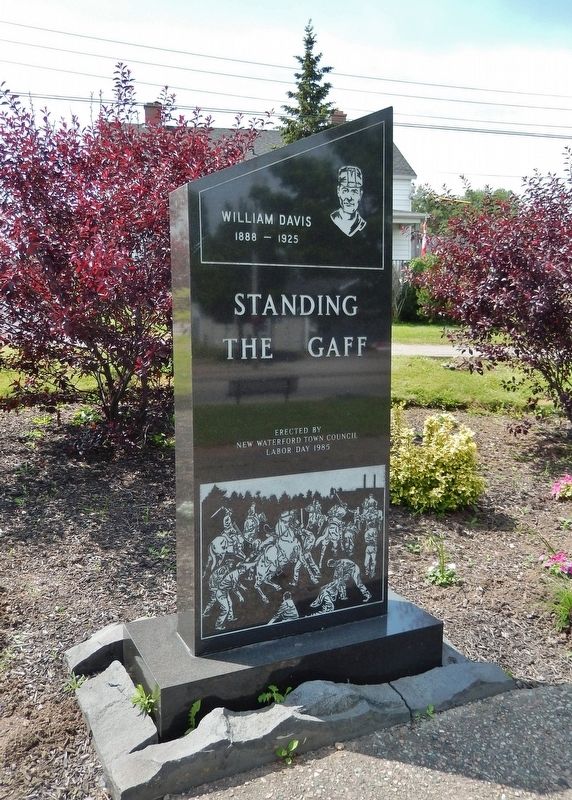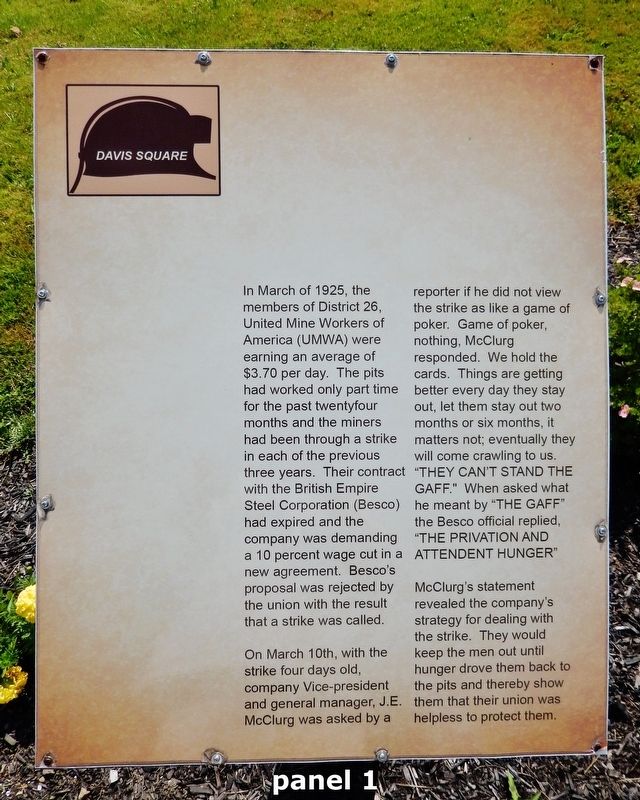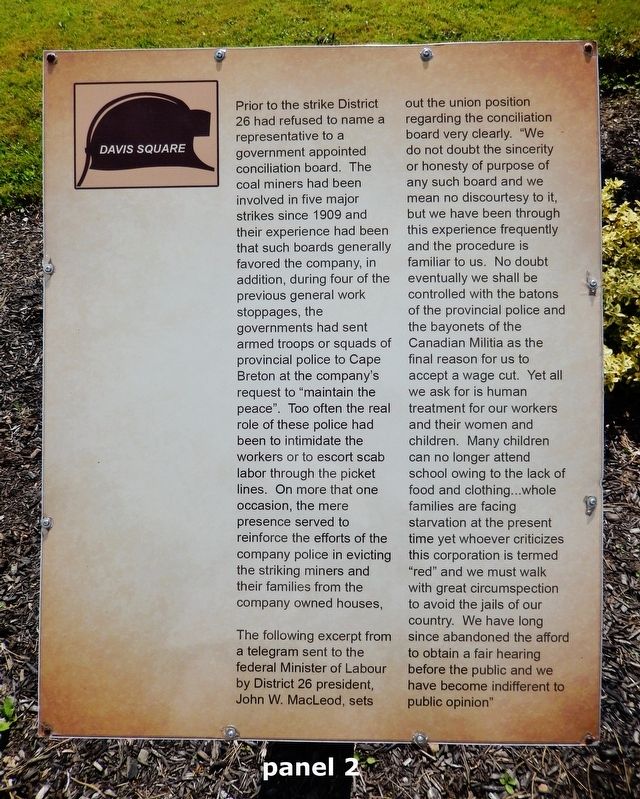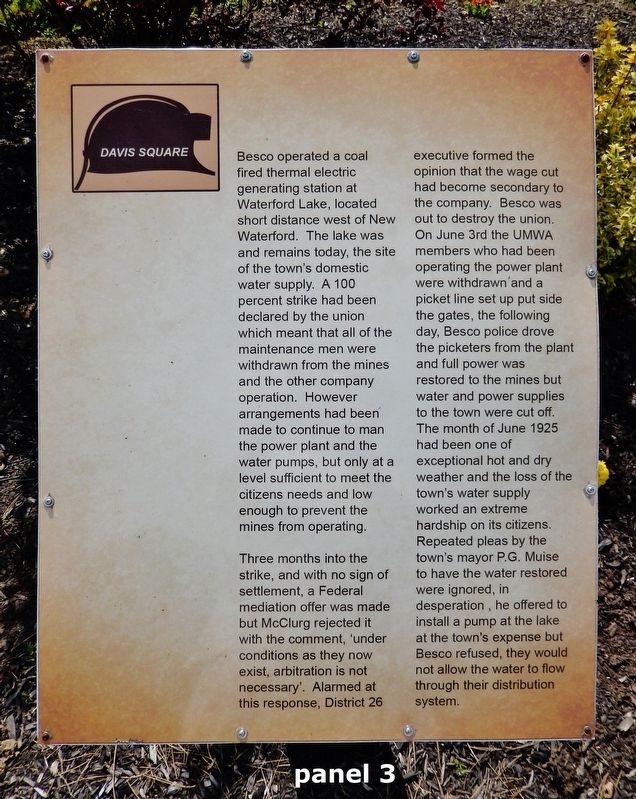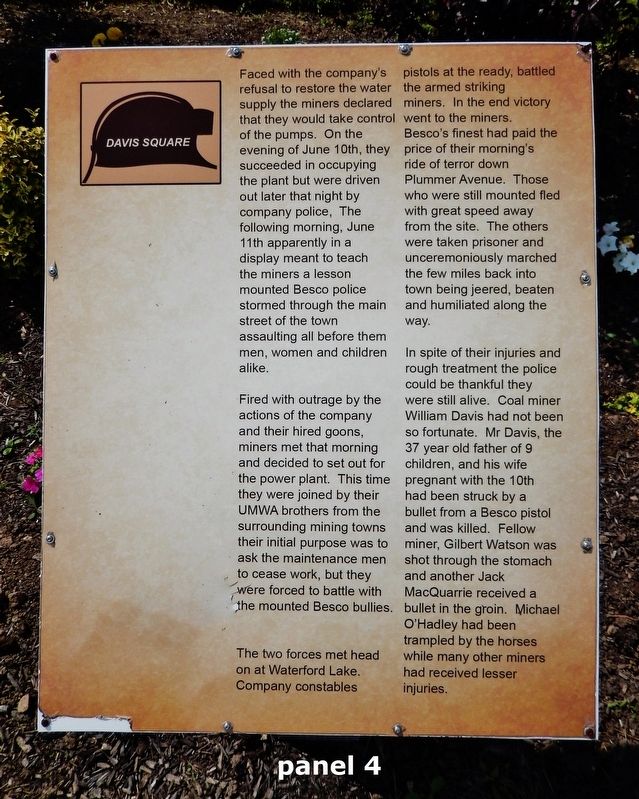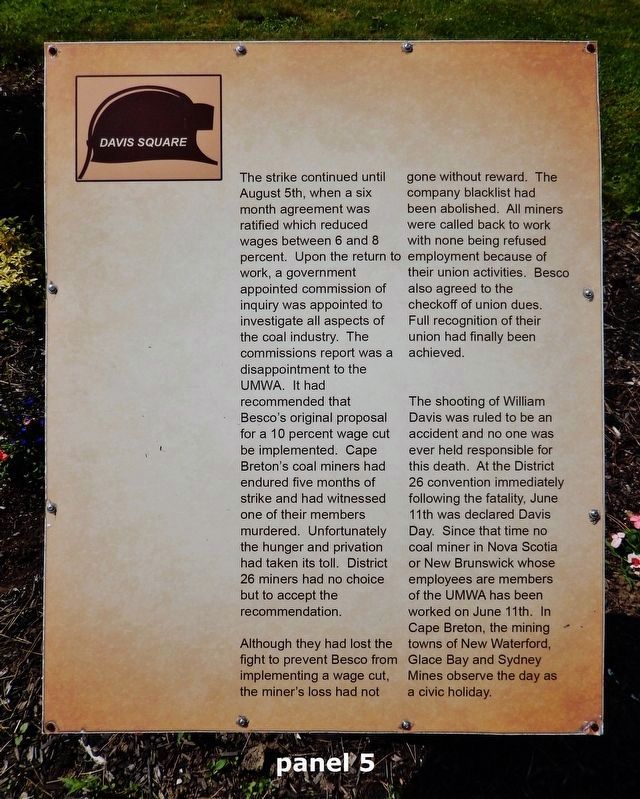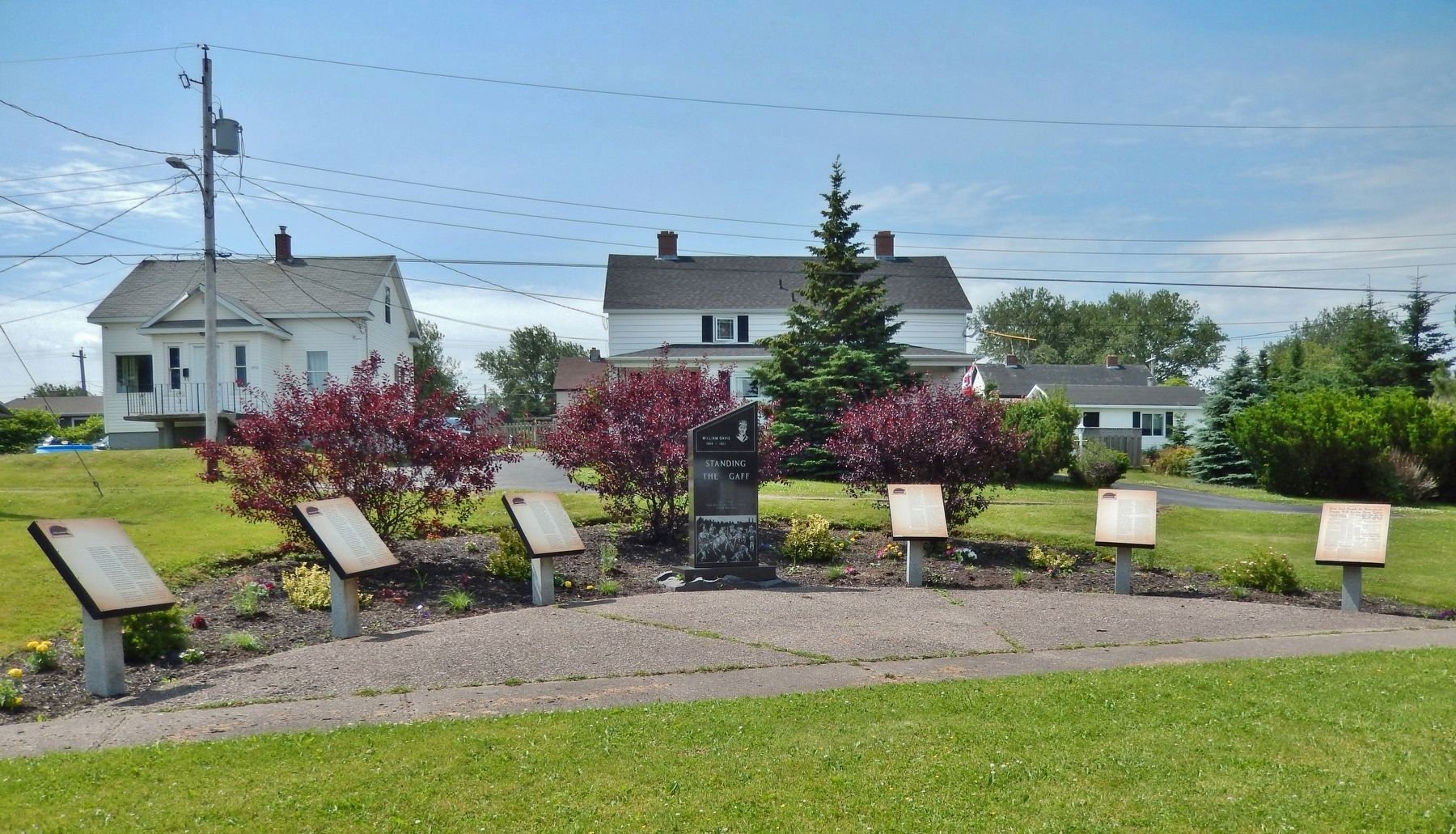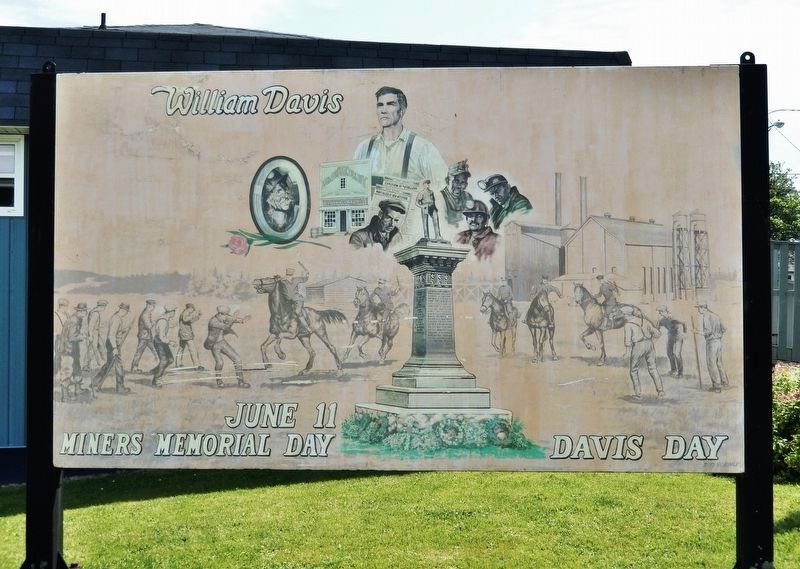New Waterford in Cape Breton Region, Nova Scotia — The Atlantic Provinces (North America)
Standing The Gaff
William Davis
— 1888-1925 —
(panel 1)
In March of 1925, the members of District 26, United Mine Workers of America (UMWA) were earning an average of $3.70 per day. The pits had worked only part time for the past twenty-four months and the miners had been through a strike in each of the previous three years. Their contract with the British Empire Steel Corporation (Besco) had expired and the company was demanding a 10 percent wage cut in a new agreement. Besco's proposal was rejected by the union with the result that a strike was called.
On March 10th, with the strike four days old, company Vice-president and general manager, J.E. McClurg was asked by a reporter if he did not view the strike as like a game of poker. Game of poker, nothing, McClurg responded. We hold the cards. Things are getting better every day they stay out, let them stay out two months or six months, it matters not; eventually they will come crawling to us. "THEY CAN'T STAND THE GAFF." When asked what he meant by "THE GAFF" the Besco official replied, "THE PRIVATION AND ATTENDENT HUNGER."
McClurg's statement revealed the company's strategy for dealing with the strike. They would keep the men out until hunger drove them back to the pits and thereby show them that their union was helpless to protect them.
(panel 2)
Prior to the strike District 26 had refused to name a representative to a government appointed conciliation board. The coal miners had been involved in five major strikes since 1909 and their experience had been that such boards generally favored the company, in addition, during four of the previous general work stoppages, the governments had sent armed troops or squads of provincial police to Cape Breton at the company's request to "maintain the peace". Too often the real role of these police had been to intimidate the workers or to escort scab labor through the picket lines. On more than one occasion, the mere presence served to reinforce the efforts of the company police in evicting the striking miners and their families from the company owned houses.
The following excerpt from a telegram sent to the federal Minister of Labour by District 26 president, John W. MacLeod, sets out the union position regarding the conciliation board very clearly. "We do not doubt the sincerity or honesty of purpose of any such board and we mean no discourtesy to it, but we have been through this experience frequently and the procedure is familiar to us. No doubt eventually we shall be controlled with the batons of the provincial police and the bayonets of the Canadian Militia as the final reason for us to accept a wage cut. Yet all we ask for is human treatment for our workers and their women and children. Many children can no longer attend school owing to the lack of food and clothing… whole families are facing starvation at the present time yet whoever criticizes this corporation is termed "red" and we must walk with great circumspection to avoid the jails of our country. We have long since abandoned the effort to obtain a fair hearing before the public and we have become indifferent to public opinion.”
(panel 3)
Besco operated a coal fired thermal electric generating station at Waterford Lake, located short distance west of New Waterford. The lake was and remains today, the site of the town's domestic water supply. A 100 percent strike had been declared by the union which meant that all of the maintenance men were withdrawn from the mines and the other company operation. However arrangements had been made to continue to man the power plant and the water pumps, but only at a level sufficient to meet the citizens needs and low enough to prevent the mines from operating.
Three months into the strike, and with no sign of settlement, a Federal mediation offer was made but McClurg rejected it with the comment, 'under conditions as they now exist, arbitration is not necessary'. Alarmed at this response, District 26 executive formed the opinion that the wage cut had become secondary to the company. Besco was out to destroy the union. On June 3rd the UMWA members who had been operating the power plant were withdrawn and a picket line set up put side the gates, the following day, Besco police drove the picketers from the plant and full power was restored to the mines but water and power supplies to the town were cut off. The month of June 1925 had been one of exceptional hot and dry weather and the loss of the town's water supply worked an extreme hardship on its citizens. Repeated pleas by the town's mayor P.G. Muise to have the water restored were ignored, in desperation, he offered to install a pump at the lake at the town's expense but Besco refused, they would not allow the water to flow through their distribution system.
(panel 4)
Faced with the company's refusal to restore the water supply the miners declared that they would take control of the pumps. On the evening of June 10th, they succeeded in occupying the plant but were driven out later that night by company police, The following morning, June 11th apparently in a display meant to teach the miners a lesson mounted Besco police stormed through the main street of the town assaulting all before them men, women and children alike.
Fired with outrage by the actions of the company and their hired goons, miners met that morning and decided to set out for the power plant. This time they were joined by their UMWA brothers from the surrounding mining towns their initial purpose was to ask the maintenance men to cease work, but they were forced to battle with the mounted Besco bullies.
The two forces met head on at Waterford Lake. Company constables pistols at the ready, battled the armed striking miners. In the end victory went to the miners. Besco's finest had paid the price of their morning's ride of terror down Plummer Avenue. Those who were still mounted fled with great speed away from the site. The others were taken prisoner and unceremoniously marched the few miles back into town being jeered, beaten and humiliated along the way.
In spite of their injuries and rough treatment the police could be thankful they were still alive. Coal miner William Davis had not been so fortunate. Mr Davis, the 37 year old father of 9 children, and his wife pregnant with the 10th had been struck by a bullet from a Besco pistol and was killed. Fellow miner, Gilbert Watson was shot through the stomach and another Jack MacQuarrie received a bullet in the groin. Michael O'Hadley had been trampled by the horses while many other miners had received lesser injuries.
(panel 5)
The strike continued until August 5th, when a six month agreement was ratified which reduced wages between 6 and 8 percent. Upon the return to work, a government appointed commission of inquiry was appointed to investigate all aspects of the coal industry. The commission’s report was a disappointment to the UMWA. It had recommended that Besco's original proposal for a 10 percent wage cut be implemented. Cape Breton's coal miners had endured five months of strike and had witnessed one of their members murdered. Unfortunately the hunger and privation had taken its toll. District 26 miners had no choice but to accept the recommendation.
Although they had lost the fight to prevent Besco from implementing a wage cut, the miner's loss had not gone without reward. The company blacklist had been abolished. All miners were called back to work with none being refused employment because of their union activities. Besco also agreed to the checkoff of union dues. Full recognition of their union had finally been achieved.
The shooting of William Davis was ruled to be an accident and no one was ever held responsible for this death. At the District 26 convention immediately following the fatality, June 11th was declared Davis Day. Since that time no coal miner in Nova Scotia or New Brunswick whose employees are members of the UMWA has been worked on June 11th. In Cape Breton, the mining towns of New Waterford, Glace Bay and Sydney Mines observe the day as a civic holiday.
Erected 1985 by New Waterford Town Council.
Topics. This historical marker is listed in these topic lists: Industry & Commerce • Labor Unions. A significant historical date for this entry is June 11, 1925.
Location. 46° 14.93′ N, 60° 5.437′ W. Marker is in New Waterford, Nova Scotia, in Cape Breton Region. Marker is on Plummer Avenue, 0 kilometers east of Baker Avenue, on the right when traveling east. Marker and monument are located in William Davis Square. Touch for map. Marker is at or near this postal address: 3453 Baker Avenue, New Waterford NS B1H 1Z6, Canada. Touch for directions.
Other nearby markers. At least 8 other markers are within 5 kilometers of this marker, measured as the crow flies. Miner's Monument (a few steps from this marker); New Waterford World War Monument (a few steps from this marker); William Davis (approx. 0.7 kilometers away); Earl Leadbeater (approx. 0.7 kilometers away); Armoured Face Conveyor (approx. 0.7 kilometers away); Joy (approx. 0.7 kilometers away); Anderton Shearer Loader (approx. 0.7 kilometers away); New Victoria Veterans Who Died Overseas (approx. 3.4 kilometers away). Touch for a list and map of all markers in New Waterford.
More about this marker. This marker comprises a polished stone monument surrounded by six interpretive panels, three on either side of the monument.
Related markers. Click here for a list of markers that are related to this marker. William Davis
Also see . . .
1. William Davis (Wikipedia)
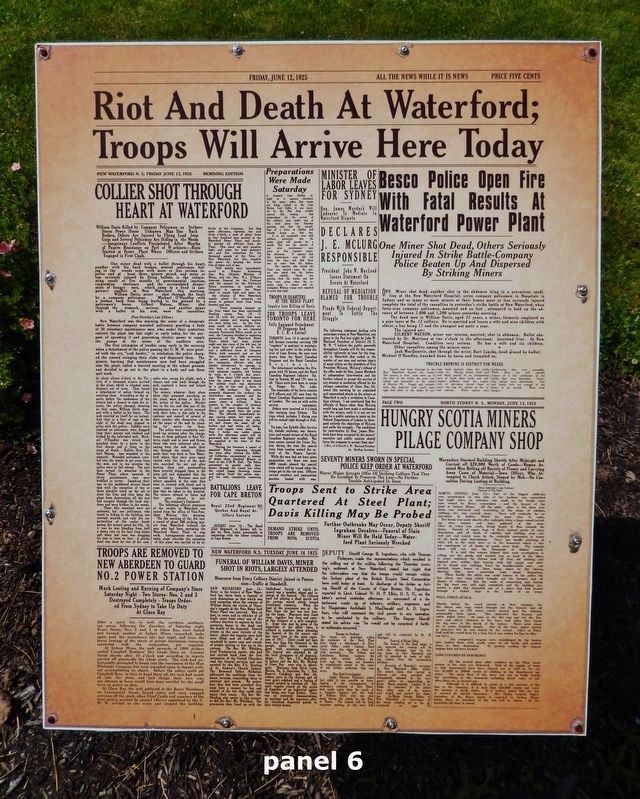
Photographed By Cosmos Mariner, July 21, 2019
7. New Waterford News, June 12, 1925 (panel 6)
Troops Will Arrive Here Today
COLLIER SHOT THROUGH HEART AT WATERFORD
• • •
2. William Davis Miners' Memorial Day (Wikipedia). Davis Day originated in memory of William Davis, a coal miner who was killed during a long strike by the province's coal miners against the British Empire Steel Corporation. The key events took place at Waterford Lake, near the town of New Waterford in the industrial district of Cape Breton Island. The situation turned critical in the early hours of June 11, when a force of company police recaptured the power plant. Hundreds of coal miners, possibly more than 2,000 in number, marched to Waterford Lake in protest. The company police started shooting and fired more than 300 shots. Davis was shot and killed, either by deliberate aim or by a stray bullet, and several other miners were wounded. (Submitted on June 21, 2020, by Cosmos Mariner of Cape Canaveral, Florida.)
Credits. This page was last revised on June 22, 2020. It was originally submitted on June 21, 2020, by Cosmos Mariner of Cape Canaveral, Florida. This page has been viewed 300 times since then and 38 times this year. Photos: 1, 2, 3, 4, 5, 6, 7, 8. submitted on June 21, 2020, by Cosmos Mariner of Cape Canaveral, Florida. 9. submitted on June 22, 2020, by Cosmos Mariner of Cape Canaveral, Florida.
